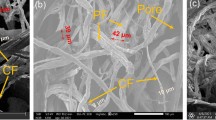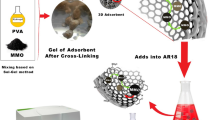Abstract
Low-quality cotton fibers are a low-value waste material within the cotton industry. Upcycling and transforming into high-value materials are highly desired. This study investigates upcycling fibers into hydrogel biosorbents and assesses their efficacy in dye adsorption. An effective gelation approach was employed via simply dropping droplets of suspension mixture of sodium alginate and fibers into acidic bath. Resulting composite hydrogel beads were utilized for dye removal. Composite beads successfully immobilized less than 70 wt% of fibers and achieved a significant improvement in thermal stability. Composite beads with 50 wt% fibers and alginate showed no decrease in methylene blue adsorption capacity. This outcome was unexpected considering the lower dye adsorption capacity of fibers than alginate, particularly notable since it indicated that reduced quantities of the more costly sodium alginate were sufficient to achieve comparable dye adsorption capacity. Mechanistic study unveiled that both the loose crosslinking structure and the electrostatic forces were responsible for the unexpected high adsorption capacity of 50% fiber-alginate. This study reports a promising, innovative and effective upcycle strategy for the first time that can transform fibers into high-value biosorbents without compromising dye adsorption capability.




Similar content being viewed by others
Data availability
Data are available upon reasonable request to the corresponding author (ZZ).
References
Baatti A, Erchiqui F, Bébin P et al (2019) Fabrication of hydrophobic cellulose nanocrystals. Can J Chem Eng 97:2050–2060
Boström M, Micheletti M (2016) Introducing the sustainability challenge of textiles and clothing. J Consum Policy 39:367–375
Dai Y, Yang J, Hu W et al (2017) Simulative global warming negatively affects cotton fiber length through shortening fiber rapid elongation duration. Sci Rep 7:9264
Draget KI, Skjåk-Bræk G, Stokke BT (2006) Similarities and differences between alginic acid gels and ionically crosslinked alginate gels. Food Hydrocoll 20:170–175
Farghali M, Mohamed IMA, Osman AI et al (2023) Seaweed for climate mitigation, wastewater treatment, bioenergy, bioplastic, biochar, food, pharmaceuticals, and cosmetics: a review. Environ Chem Lett 21:97–152
Hamidon TS, Adnan R, Haafiz MKM et al (2022) Cellulose-based beads for the adsorptive removal of wastewater effluents: a review. Environ Chem Lett 20:1965–2017
Janhom S, Watanesk R, Watanesk S et al (2006) Comparative study of lac dye adsorption on cotton fibre surface modified by synthetic and natural polymers. Dyes Pigm 71:188–193
Kim HJ, Liu Y, French AD et al (2018) Comparison and validation of Fourier transform infrared spectroscopic methods for monitoring secondary cell wall cellulose from cotton fibers. Cellulose 25:49–64
Lin YH, Liang HF, Chung CK et al (2005) Physically crosslinked alginate/N, O-carboxymethyl chitosan hydrogels with calcium for oral delivery of protein drugs. Biomaterials 26:2105–2113
Nam S, French AD, Condon BD et al (2016) Segal crystallinity index revisited by the simulation of X-ray diffraction patterns of cotton cellulose Iβ and cellulose II. Carbohydr Polym 135:1–9
Ovchinnikov OV, Evtukhova AV, Kondratenko TS et al (2016) Manifestation of intermolecular interactions in FTIR spectra of methylene blue molecules. Vib Spectrosc 86:181–189
Rudhziah S, Rani MSA, Ahmad A et al (2015) Potential of blend of kappa-carrageenan and cellulose derivatives for green polymer electrolyte application. Ind Crops Prod 72:133–141
Rumi SS, Liyanage S, Abidi N (2021) Conversion of low-quality cotton to bioplastics. Cellulose 28:2021–2038
Shi W, Zhang J, Shi XM et al (2008) Different photodegradation processes of PVC with different average degrees of polymerization. J Appl Polym Sci 107:528–540
Song P, Xu Z, Guo Q (2013) Bioinspired strategy to reinforce PVA with Improved toughness and thermal properties via hydrogen-bond self-assembly. ACS Macro Lett 2:1100–1104
Wang B, Wan Y, Zheng Y et al (2019) Alginate-based composites for environmental applications: a critical review. Crit Rev Environ Sci Technol 49:318–356
Yang X, Fan W, Wang H et al (2022a) Recycling of bast textile wastes into high value-added products: a review. Environ Chem Lett 20:3747–3763
Yang Y, Zhu Q, Peng X et al (2022b) Hydrogels for the removal of the methylene blue dye from wastewater: a review. Environ Chem Lett 20:2665–2685
Zhang Z, Lucia L, Abidi N (2022) Composites hydrogels with enhanced solid foam formation. Compos Commun 35:101334
Zhang Z, Abidi N, Lucia L (2023a) Smart superabsorbent alginate/carboxymethyl chitosan composite hydrogel beads as efficient biosorbents for methylene blue dye removal. J Mater Sci Technol 159:81–90
Zhang Z, Abidi N, Lucia L et al (2023b) Cellulose/nanocellulose superabsorbent hydrogels as a sustainable platform for materials applications: a mini-review and perspective. Carbohydr Polym 299:120140
Funding
This work is funded by the Texas State Support Committee (Agreement #17-512TX).
Author information
Authors and Affiliations
Contributions
ZZ helped in conceptualization, methodology, investigation, data curation, review and edit; SSR conducted XRD and TGA experiments; LAL was involved in review and edit; NA performed project administration, review and edit.
Corresponding authors
Ethics declarations
Conflict of interest
The authors have no known conflict of interest to declare.
Additional information
Publisher's Note
Springer Nature remains neutral with regard to jurisdictional claims in published maps and institutional affiliations.
Supplementary Information
Below is the link to the electronic supplementary material.
Rights and permissions
Springer Nature or its licensor (e.g. a society or other partner) holds exclusive rights to this article under a publishing agreement with the author(s) or other rightsholder(s); author self-archiving of the accepted manuscript version of this article is solely governed by the terms of such publishing agreement and applicable law.
About this article
Cite this article
Zhang, Z., Rumi, S.S., Lucia, L.A. et al. Transforming low-quality cotton fibers into dye adsorbents. Environ Chem Lett 22, 981–987 (2024). https://doi.org/10.1007/s10311-023-01692-1
Received:
Accepted:
Published:
Issue Date:
DOI: https://doi.org/10.1007/s10311-023-01692-1




